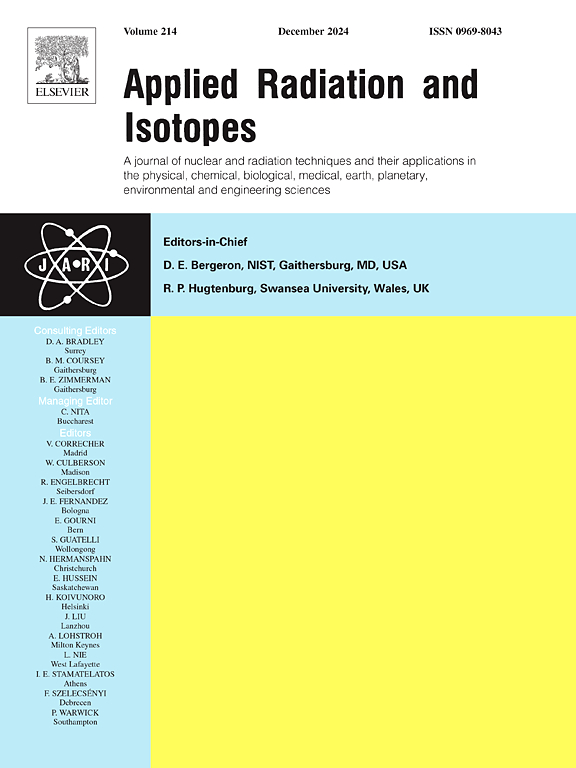A study on the interaction parameters of charged and uncharged radiation types with some indoor plants
IF 1.6
3区 工程技术
Q3 CHEMISTRY, INORGANIC & NUCLEAR
引用次数: 0
Abstract
This study investigates how gamma rays, neutrons, and electrons interact with five commonly found indoor plants: Spathiphyllum wallisii (SW), Ficus elastica (FE), Dieffenbachia camilla (DC), Schefflera arboricola (SA), and Ficus benjamina (FB). Utilizing experimental measurements (with HPGe detector), Monte Carlo simulations (GEANT4 and FLUKA), and theoretical calculations (ESTAR and WinXCOM), some radiation interaction parameters for gamma rays, fast neutrons, thermal neutrons, and electrons were determined. Secondary particle generation was also analyzed to provide a comprehensive assessment. The determined linear attenuation coefficients with the help of the WinXCOM are 0.1376, 0.1662, 0.1385, 0.1651 and 0.1698 cm−1 for SW, FE, DC, SA and FB, respectively. The calculated total macroscopic cross sections for indoor plants in the same sample order are 2.0290, 2.0350, 2.0285, 2.0363 and 2.0362 cm−1. Among the investigated plants, FB exhibited the highest gamma ray interaction, while SA and FB showed superior interaction against fast neutrons compared to SW and DC. The findings reveal significant variations in interaction effectiveness and secondary radiation production across these plants, offering valuable insights for radiation safety and environmental health evaluations.
带电和不带电辐射类型与一些室内植物相互作用参数的研究。
本研究调查了伽马射线、中子和电子如何与五种常见的室内植物相互作用:Spathiphyllum wallisii (SW)、Ficus elastica (FE)、Dieffenbachia camilla (DC)、Schefflera arboricola (SA) 和 Ficus benjamina (FB)。通过实验测量(使用 HPGe 探测器)、蒙特卡罗模拟(GEANT4 和 FLUKA)和理论计算(ESTAR 和 WinXCOM),确定了伽马射线、快中子、热中子和电子的一些辐射相互作用参数。此外,还对二次粒子的产生进行了分析,以提供全面的评估。借助 WinXCOM 确定的 SW、FE、DC、SA 和 FB 线性衰减系数分别为 0.1376、0.1662、0.1385、0.1651 和 0.1698 cm-1。按照相同的样本顺序计算出的室内植物总宏观横截面分别为 2.0290、2.0350、2.0285、2.0363 和 2.0362 cm-1。在调查的植物中,FB 对伽马射线的相互作用最高,而 SA 和 FB 对快中子的相互作用则优于 SW 和 DC。研究结果揭示了这些植物在相互作用效果和二次辐射产生方面的显著差异,为辐射安全和环境健康评估提供了有价值的见解。
本文章由计算机程序翻译,如有差异,请以英文原文为准。
求助全文
约1分钟内获得全文
求助全文
来源期刊

Applied Radiation and Isotopes
工程技术-核科学技术
CiteScore
3.00
自引率
12.50%
发文量
406
审稿时长
13.5 months
期刊介绍:
Applied Radiation and Isotopes provides a high quality medium for the publication of substantial, original and scientific and technological papers on the development and peaceful application of nuclear, radiation and radionuclide techniques in chemistry, physics, biochemistry, biology, medicine, security, engineering and in the earth, planetary and environmental sciences, all including dosimetry. Nuclear techniques are defined in the broadest sense and both experimental and theoretical papers are welcome. They include the development and use of α- and β-particles, X-rays and γ-rays, neutrons and other nuclear particles and radiations from all sources, including radionuclides, synchrotron sources, cyclotrons and reactors and from the natural environment.
The journal aims to publish papers with significance to an international audience, containing substantial novelty and scientific impact. The Editors reserve the rights to reject, with or without external review, papers that do not meet these criteria.
Papers dealing with radiation processing, i.e., where radiation is used to bring about a biological, chemical or physical change in a material, should be directed to our sister journal Radiation Physics and Chemistry.
 求助内容:
求助内容: 应助结果提醒方式:
应助结果提醒方式:


